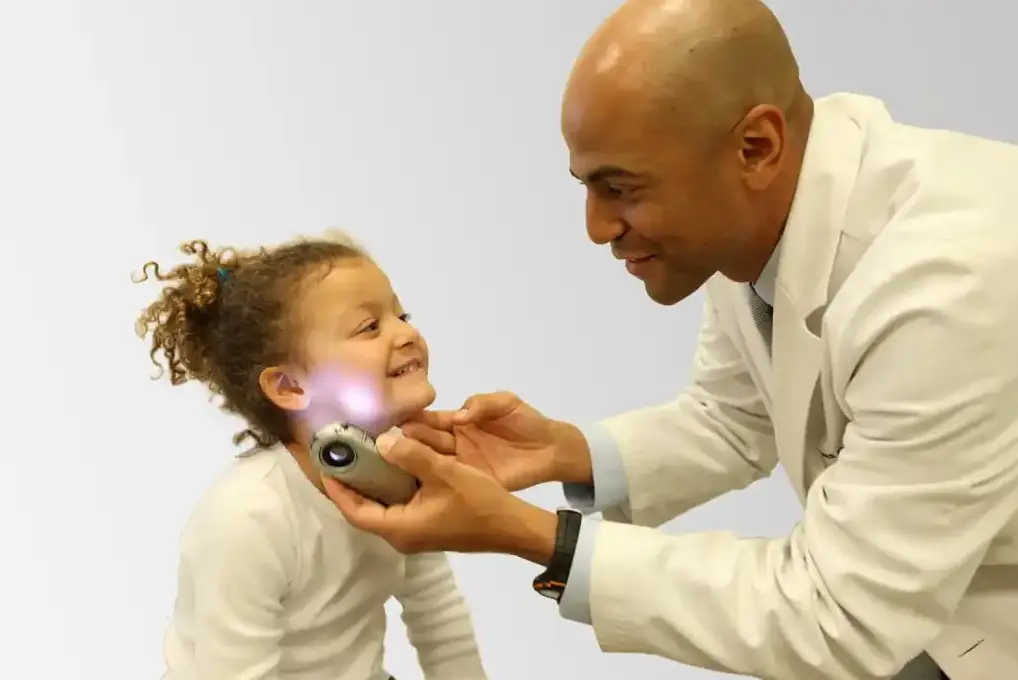Pediatric Dermatology in New York, NY

Pediatric Dermatology in New York, NY
Pediatric dermatology focuses on diagnosing and addressing skin conditions in children, from infants to adolescents. This specialty addresses various issues, including congenital skin disorders, infections, and common childhood skin problems. Pediatric dermatologists are trained to understand the unique needs of children’s skin, which differs from adults in sensitivity and developmental changes. Treatments are tailored to provide adequate relief while considering the child’s comfort and growth. By addressing medical and cosmetic concerns, pediatric dermatologists ensure their young patients’ healthy skin and overall well-being.
How Does Pediatric Dermatology Work?
Pediatric dermatology involves a comprehensive approach to managing skin conditions in children. The process starts with a detailed consultation, during which the pediatric dermatologist reviews the child’s medical history and discusses any symptoms or concerns with the family. A thorough physical examination of the skin follows, which helps diagnose the condition.
Additional diagnostic tests, such as skin biopsies, allergy tests, or cultures, may be conducted based on the initial findings. These tests help pinpoint the exact cause of the skin issue. Once a diagnosis is made, a customized treatment plan is developed. This plan may include topical medications, oral treatments, lifestyle and skincare recommendations, or other interventions to address the child’s needs. The approach ensures that treatments are effective and suitable for the child’s age and skin type.
What are the different conditions that pediatric dermatology can treat?
Eczema (Atopic Dermatitis)
Eczema is a common condition in children that causes itchy, inflamed skin. Treatment involves moisturizers to keep the skin hydrated and topical corticosteroids to reduce inflammation. Pediatric dermatologists may also suggest avoiding known triggers, such as certain soaps or fabrics, and incorporating mild, fragrance-free products into the child’s skincare routine.
Psoriasis
Psoriasis is an autoimmune disorder leading to red, scaly patches on the skin. Pediatric dermatologists treat this condition with topical therapies, such as corticosteroids and vitamin D analogs, as well as phototherapy and systemic medications in more severe cases. Managing psoriasis often involves regular follow-up to adjust treatments and monitor the child’s response.
Acne
Acne is common among teenagers and can manifest as pimples, blackheads, or cysts. Treatments include topical retinoids, antibiotics, and oral medications, depending on the severity. Pediatric dermatologists also guide skincare routines and lifestyle adjustments to help manage and reduce acne outbreaks.
Warts
Warts are benign growths caused by the human papillomavirus (HPV). Pediatric dermatologists treat warts using cryotherapy to freeze them off, topical treatments to dissolve the wart tissue, or minor surgical procedures for persistent warts. Effective treatment helps prevent the spread of warts to other areas of the body.
Birthmarks
Birthmarks vary widely in appearance, including hemangiomas, pigmented lesions, and vascular malformations. Pediatric dermatologists assess these marks and recommend treatments ranging from observation to laser therapy or surgical removal, depending on the type, size, and potential impact on the child’s health.
Skin Infections
Children can experience bacterial, viral, or fungal skin infections. Pediatric dermatologists diagnose these infections through physical examination and, if necessary, laboratory tests. Treatments include topical or oral antibiotics for bacterial infections, antifungal treatments for fungal issues, and antiviral medications for viral conditions.
Pediatric dermatology Before & After Pictures

What Are the Results of Pediatric Dermatology Treatments?
The outcomes of pediatric dermatology treatments vary depending on the condition and its severity. For most skin conditions, treatments aim to relieve symptoms, prevent recurrence, and improve skin appearance. With appropriate treatment, conditions like eczema and acne can be effectively managed, significantly improving the child’s comfort and quality of life. Conditions such as warts and birthmarks can often be resolved with targeted interventions, minimizing their impact on the child’s health and self-esteem. Pediatric dermatologists work closely with families to ensure the best possible outcomes by monitoring progress and adjusting treatments as needed.
If you’re seeking expert care for your child’s skin condition, consider scheduling an appointment with Park Plaza Dermatology in New York, NY. Our experienced team specializes in pediatric dermatology and is dedicated to providing tailored treatment plans to address your child’s unique needs. Contact us today to learn more and book your consultation.
Benefits of Pediatric Dermatology include
- Accurate diagnosis of skin conditions specific to children.
- Personalized treatment plans tailored to each child's needs.
- Use of safe, age-appropriate medications and therapies.
- Effective management of chronic conditions like eczema and psoriasis.
- Expertise in handling sensitive skin and congenital disorders.
- Prevention of skin conditions from worsening or recurring.
- Reduction of symptoms and improvement in skin appearance.
- Support and guidance for parents on skincare routines and lifestyle adjustments.
- Access to specialized treatments for complex or rare skin conditions.
- Enhanced overall skin health and comfort for children.
Frequently Asked Questions
During a pediatric dermatology consultation, the dermatologist will review your child’s medical history, discuss their skin concerns, and perform a physical examination. Depending on the condition, additional tests may be conducted to diagnose the issue accurately. The dermatologist will develop a personalized treatment plan and discuss your next steps.
Yes, pediatric dermatology treatments are specifically designed to be safe for children. Pediatric dermatologists use age-appropriate medications and techniques to ensure effective treatments while minimizing potential side effects. They also consider the child’s developmental stage and overall health when prescribing medicines.
The time it takes to see effects varies depending on the treatment condition and the chosen treatment method. Some conditions can improve within a few weeks, while others may take several months. The dermatologist will provide a timeline and expectations based on the treatment plan.
Common side effects of pediatric dermatology treatments may include mild skin irritation, redness, or dryness. These effects are generally temporary and resolve as the skin adjusts to the treatment. Your dermatologist will monitor your child’s response to treatment and make necessary adjustments to minimize any side effects.
Pediatric dermatology can address cosmetic concerns, such as acne scars or prominent birthmarks, that may affect a child’s appearance and self-esteem. Treatments are provided with sensitivity to ensure they are suitable for the child’s age and specific needs.
You should consult a pediatric dermatologist if your child has persistent or severe skin issues that do not improve with over-the-counter treatments. It is also advisable to seek a specialist if your child has a complex skin condition, recurrent infections, or concerns about the appearance or health of their skin.
